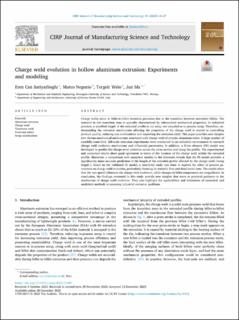| dc.contributor.author | Sariyarlioglu, Eren Can | |
| dc.contributor.author | Negozio, Marco | |
| dc.contributor.author | Welo, Torgeir | |
| dc.contributor.author | Ma, Jun | |
| dc.date.accessioned | 2024-02-26T08:29:18Z | |
| dc.date.available | 2024-02-26T08:29:18Z | |
| dc.date.created | 2024-01-09T14:31:41Z | |
| dc.date.issued | 2024 | |
| dc.identifier.citation | CIRP - Journal of Manufacturing Science and Technology. 2024, 49 14-27. | en_US |
| dc.identifier.issn | 1755-5817 | |
| dc.identifier.uri | https://hdl.handle.net/11250/3119795 | |
| dc.description.abstract | Charge welds occur in billet-to-billet extrusion processes due to the transition between successive billets. The material in this transition zone is typically characterized by substandard mechanical properties. In industrial practice, a specified length of the extruded profile is cut away and recycled as in-process scrap. Therefore, understanding the extrusion mechanisms affecting the properties of the charge weld is crucial to controlling product quality, reducing non-conformities and improving the extrusion yield. This paper provides new insights into thermo-mechanical mechanisms associated with charge weld of circular aluminum tubes. A large number of carefully-controlled, full-scale extrusion experiments were conducted in an industrial environment to research charge weld evolution mechanisms and influential parameters. In addition, a finite element (FE) model was developed to predict the charge weld evolution across the cross section and along the profile. The experimental and numerical results show good agreement in terms of the location of the charge weld within the extruded profile. Moreover, a comparison with analytical models in the literature reveals that the FE model provides a significantly more accurate prediction of the length of the extruded profile affected by the charge weld (‘scrap length’). Based on the validated FE model, a sensitivity study was done to explore the effect of process parameters on charge weld evolution, particularly focusing on material flow and dead metal zone. The results show that the ram speed influences the charge weld evolution, while changes in billet temperature are insignificant. In conclusion, the findings presented in this study provide new insights that serve as practical guidance to the mechanism of charge weld evolution. They also highlight the applicability and limitations of numerical and analytical methods in assessing industrial extrusion problems. | en_US |
| dc.language.iso | eng | en_US |
| dc.publisher | Elsevier | en_US |
| dc.rights | Navngivelse 4.0 Internasjonal | * |
| dc.rights.uri | http://creativecommons.org/licenses/by/4.0/deed.no | * |
| dc.title | Charge weld evolution in hollow aluminum extrusion: Experiments and modeling | en_US |
| dc.title.alternative | Charge weld evolution in hollow aluminum extrusion: Experiments and modeling | en_US |
| dc.type | Peer reviewed | en_US |
| dc.type | Journal article | en_US |
| dc.description.version | publishedVersion | en_US |
| dc.source.pagenumber | 14-27 | en_US |
| dc.source.volume | 49 | en_US |
| dc.source.journal | CIRP - Journal of Manufacturing Science and Technology | en_US |
| dc.identifier.doi | 10.1016/j.cirpj.2023.12.007 | |
| dc.identifier.cristin | 2223308 | |
| cristin.ispublished | true | |
| cristin.fulltext | original | |
| cristin.qualitycode | 2 | |

